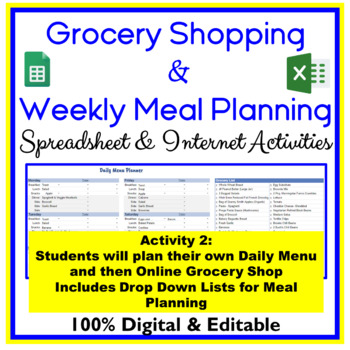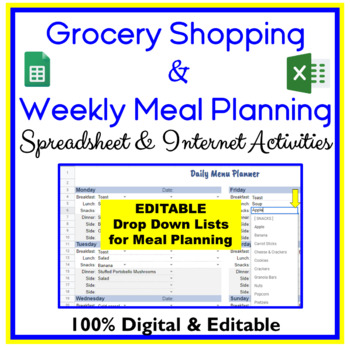Grocery Shopping & Meal Planning Spreadsheet Activities Google Sheets Excel
- PDF
- Google Apps™
- Internet Activities
- Excel Spreadsheets

Description
100% DIGITAL AND EDITABLE Interactive Spreadsheet Activities – Two Google Sheets/Microsoft Excel Activities will teach your students how to online grocery shop. Students will learn to navigate an online grocery store website, determine current price of grocery items, determine brand and size/unit/count, etc., locate sale items, and compare prices. Students will learn just how much groceries cost! Downloads in Google Sheets and works perfectly in Microsoft Excel. Includes a link for students to online grocery shop.
Activity 1 – Students are given a spreadsheet of 50 items to purchase that an average family of 4 might shop for in a given week. Students will learn how to shop for name brands, store brands, locate correct sizes/units/count, etc. Students will enter the data into the spreadsheet (download includes calculations so students can focus on shopping).
Follow Up Collaboration Activity – Students that shopped at the same store share their spreadsheets to view the differences and make comments to discuss why the TOTAL amounts vary.
Activity 2 – Students are given a spreadsheet to plan their OWN MEALS for 1 week and then grocery shop for the items. The spreadsheet includes dropdown boxes for easy entry and suggestions for meals (students are able to EDIT to customize their food choices).
These activities are perfect for upper middle school, high school, and special education students to learn to grocery shop online and plan a weekly menu for themselves.
Grocery Shopping Spreadsheet Activities Includes:
- Link to Google Sheets Weekly Grocery Shopping List Activity 1
- Link to Google Sheets Daily Meal Planner & Grocery Shopping Activity 2
- Sample Answer Key for Activity 2
- Teacher Directions





